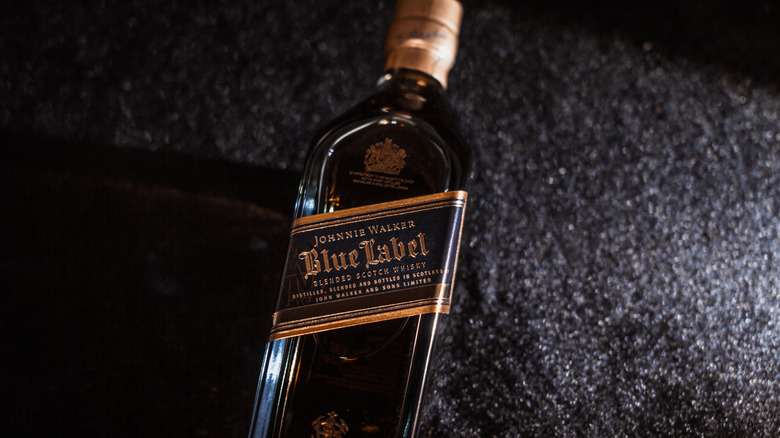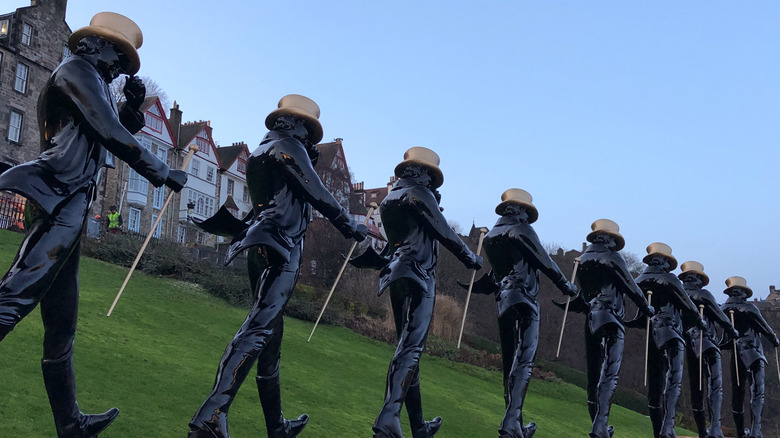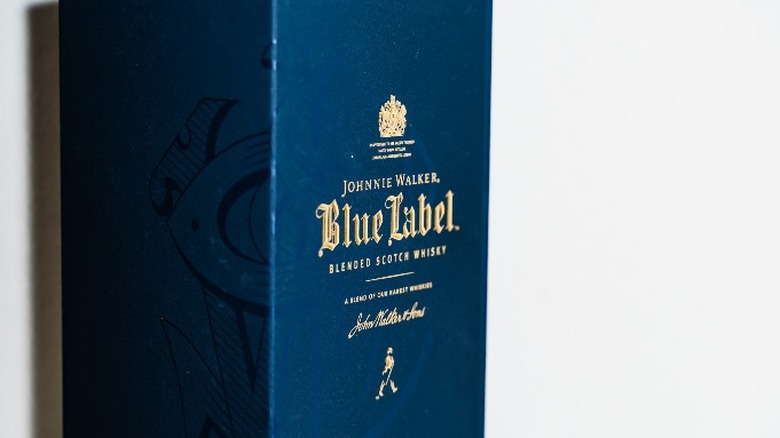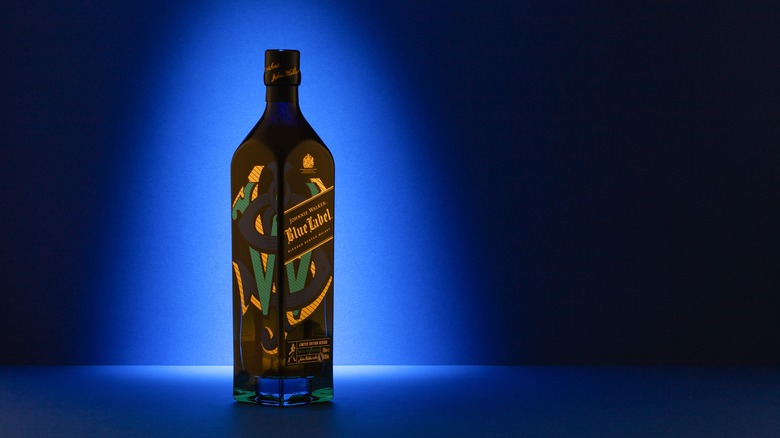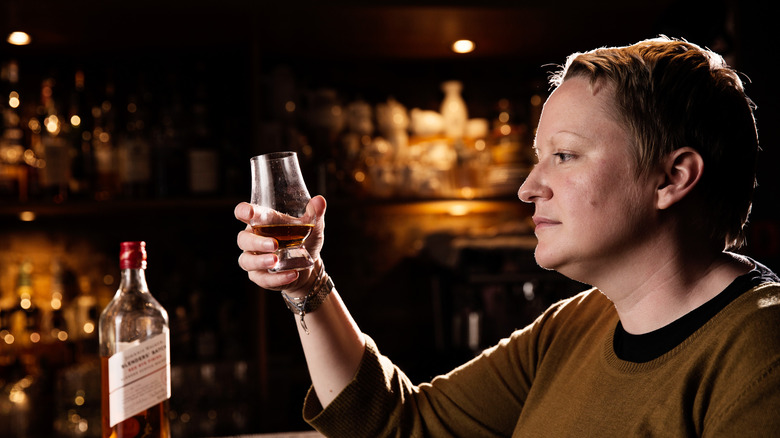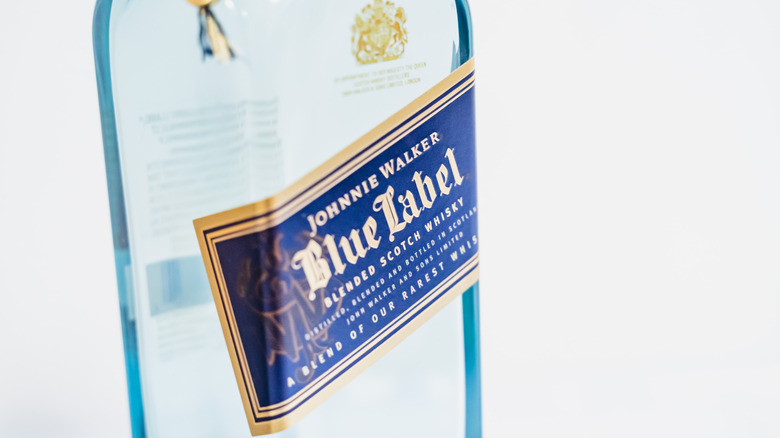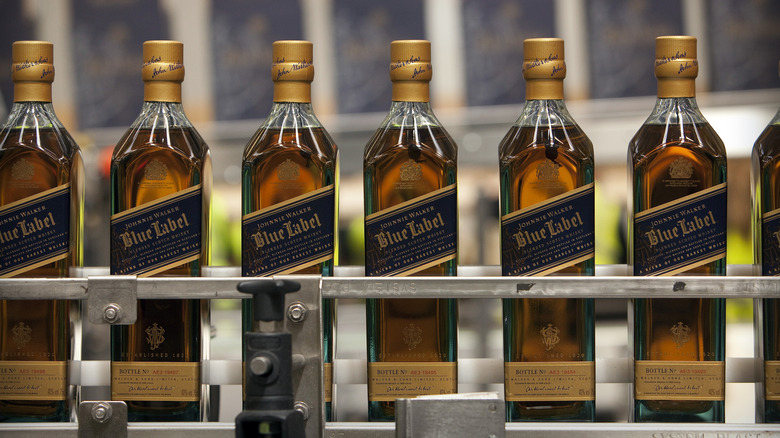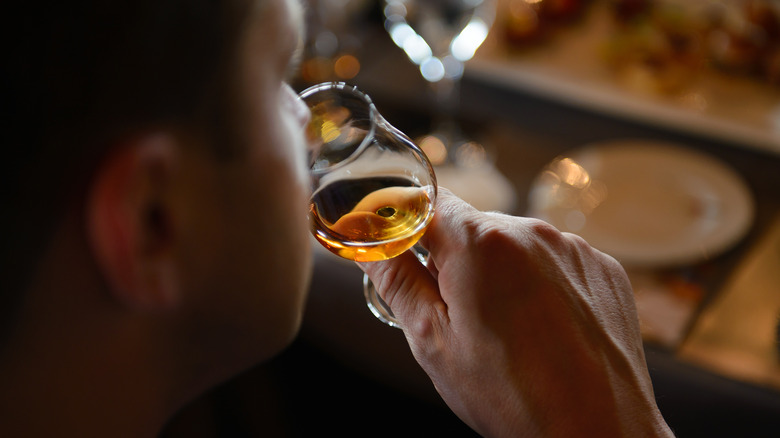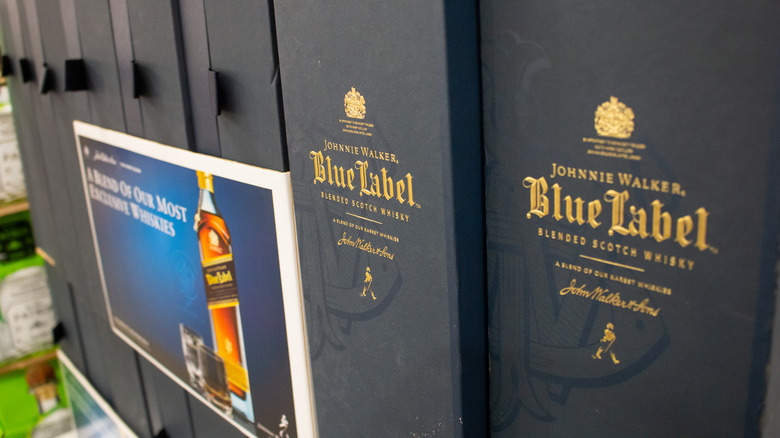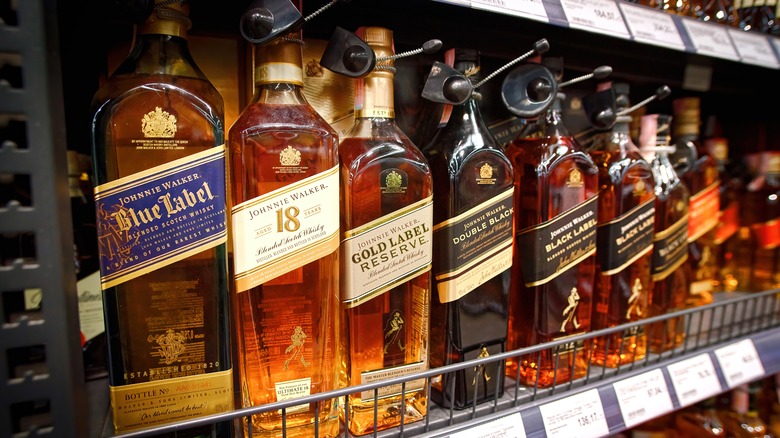Johnnie Walker Blue Label: The Ultimate Bottle Guide
Johnnie Walker is one of the most iconic spirits on the planet. Everything from the square bottle to the slanted label to the Striding Man emblem makes Johnnie Walker the top dog in its industry. What began as a shelf stock in a general store over 200 years ago has since blossomed into a global empire.
Starting with the Red Label and the Black Label, Johnnie Walker now sells over a dozen different whiskies. Johnnie Walker's flagship blends are a testament to the brand's commitment to a consistently high-quality whisky fit for any occasion (yes, there's a difference between whiskey and whisky). Johnnie Walker Blue Label, however, stands alone as the cream of the Johnnie Walker crop. Every whisky in the Johnnie Walker lineup is worth trying, but Blue Label carries a sort of mystique; an intangible appeal worthy of the praise and price tag. Blue Label is, at its core, a celebration.
Blue Label is a relatively new addition to the lineup
The Johnnie Walker brand was built on the foundation of the Red Label and Black Label, and they became the standard of Scotch whisky throughout the 20th century. The brand was thriving, but the Striding Man always looks ahead. According to Punch, Guinness UDV, Johnnie Walker's then-owner, saw a niche in the market to be filled by a status symbol spirit in the late 1980s. Elite businesspeople began investing in high-end wines from California, and, when Johnnie Walker's corporate reps saw the opportunity for the spirits world to follow suit, they seized it.
Focus groups were held in the form of whisky dinners where marketing executives would gather data firsthand from members of this high-end demographic, said Punch. Johnnie Walker's flagship bottles, Red Label and Black Label, were not the participants' favorites, as the bottles' supposed lack of echelon was not deemed suitable for their palates. Instead, a spirit that evoked rarity, exclusivity, and luxury was in demand — Blue Label was exactly what they were looking for. Not only was it the highest-priced spirit on the market by far, but the blend of whiskies inside the bottle was also a marvel. Containing whisky only 28-years-old and above, Blue Label was unlike anything else on the market. It became an instant status symbol, referred to by whisky seller and author Robert Robinson for Punch as "the most perfectly engineered whisky ever created."
It's a highly-awarded Scotch
Johnnie Walker Blue Label's debut in 1992 sparked a run of thriving longevity that has ceased to slow down and continues to bask in accolades today.
Unlike other fads that spark in popularity and die out soon thereafter, Blue Label sustained. While other distilleries tried to catch up with the prestige of Blue Label and more and more were born through the bourbon boom of the 2000s, Blue Label remained at the top. According to Master of Malt, Blue Label was awarded double gold at the San Francisco World Spirits Competition in 2013, gold by the Scotch Whisky Masters in 2019, and gold in the International Spirits Challenge in 2020.
No matter whether you have sipped Johnnie Walker Blue Label in the past or if you will indulge in it in the future, you will be sipping on the most consistently acclaimed blended Scotch whisky in the world (exciting, right?).
There are multiple special edition blends
Although Blue Label is so acclaimed that it never has to change, Johnnie Walker is always introducing special edition blends and bottles to commemorate milestones and keep fans on their toes. In 2020, Johnnie Walker announced a limited edition bottle of Blue Label to commemorate the 2020 Chinese New Year called "Year of the Tiger," says Reserve Bar. The colorful limited edition bottle showcases traditional Chinese patterns to celebrate the strides of Chinese New Year recognition and how celebrations have become a global event. This special edition Blue Label is currently retailing for $299.
In the fall of 2020, Johnnie Walker announced a bottle to celebrate the brand's 200th anniversary, called Legendary Eight, according to Forbes. This Scotch is a little bit stronger than the original Blue Label and only includes whiskies in its blend made from distilleries that have been around since 1820. Retailing at $350 a bottle, Legendary Eight pays homage to the past as well as looks ahead to what is to come for the brand.
The Ghost series is thanks to Johnnie Walker's first female master blender
Johnnie Walker has been in operation for over two centuries, but despite that longevity, a woman has never held the position of master blender — until recently. In fall 2021, Emma Walker was promoted to that position. Beginning at the company 13 years ago, says The Whiskey Wash, Walker is responsible for the blends for Johnnie Walker Blue Label Ghost and Rare series that debuted in 2019. Now, as master blender, Walker leads a 12-person team to create, hone, and perfect new variants of Johnnie Walker.
When asked about the impact of gender roles on the world of whisky in an interview with Forbes, Walker replied, "We strongly believe whisky is for everyone and we're encouraging inclusion and diversity in every sense, in the workplace, in our communities, and with our consumers." Emma Walker is a living, thriving representation of the Johnnie Walker brand and the innovative spirit that has sustained it for over 200 years. The Johnnie Walker traditions she is pushing forward will hopefully continue to inspire and support her vision until the end of her tenure.
What does Blue Label taste like?
Johnnie Walker Blue Label takes all of the aromas and flavors of good Scotch and enhances them to the pinnacle of their capabilities. Blended Scotch is already the perfect avenue toward encapsulating everything great in Scotch whisky and presenting it in a single spirit, and Blue Label not only accomplishes this feat but there is no other blended whisky that can match it.
According to The Whiskey Wash, the golden amber Blue Label brings your nose hints of cocoa, cedar, roasted coffee, and light tobacco smoke. Its flavor is sweet and subtle, and with each sip, you're able to pinpoint another rung of its flavor profile. With light wisps of peat smoke, charred oak, rich vanilla, and caramel, the blend of Blue Label grants you a layered experience that is consistent yet intriguing. The finish is satisfyingly absent of any burn, but it does not feel like something is missing. This Scotch is full-bodied yet delicate; complex, yet subtle. Every sip you take grants you new discoveries from the previous one. Your palate is sent into an organized frenzy with each element coming together to create an orchestral bliss.
How is Blue Label made?
Johnnie Walker Blue Label is a blended Scotch whisky, as the website notes, which means it's a calculated mix of single malt Scotch and grain whisky. Single malt Scotches are made from one singular type of malted barley, and they vary in flavor based on their respective region in Scotland. Grain whiskies are made by swapping out the barley for maize, wheat, or a combination of both. This makes for a lighter, more delicate whisky.
Blended whiskies tie together the best of both worlds. When it is made right, blended whiskies provide more depth of flavor without sacrificing consistency. Blue Label nails those elements. Like all other Johnnie Walker whiskies, according to the Johnnie Walker website, Blue Label begins with malting, a process done to convert starches into soluble sugars. From there, the malt is dried, ground, and prepared for fermentation. Essential sugars are drawn out, separated, and added to yeast to ferment. After fermentation, it's distilled twice to enhance alcohol content and flavor. Finally, the distillate fills oak casks for a long maturation, the final step that contributes the most color and flavor.
The standard minimum for maturation is three years. The blend that fills Blue Label bottles must reach a minimum of 28-years-old, and some single-malts are as old as 60 years. Only one in 10,000 casks are considered worthy of entering the blend that makes up the extraordinary Blue Label.
How should you drink Blue Label?
While there are many classic cocktails made with Scotch whiskies, such as The Rusty Nail, Penicillin, or the delightfully simple Scotch and soda, Johnnie Walker Blue Label is fit to be enjoyed on its own. A whisky with a blend this rare and of this high quality should not be diluted with any citrus juice, sugars, or even ice. It is not meant for hasty intoxication or even casual drinking. Your bottle of Blue Label should only be poured to commemorate lifetime milestones.
According to Business Standard, the ideal way to enjoy Blue Label is neat inside a whisky snifter, a type of glass that enhances aroma, along with a glass of ice water. The purpose of the water is to cleanse your palate after each sip so that you can make the most of every drop of whisky. Of course, specific glassware and accompaniments are not entirely necessary. The only true necessity you need to drink Blue Label is to enjoy it with loved ones on a special day.
Not to mention, for the price you are paying for the bottle, every sip of it should be considered an indulgence fit only for special occasions. Some people may only own one bottle of Blue Label their entire life. You should make the most of it.
How much does Blue Label cost?
The many aspects that make Blue Label one of the leading spirits of the world do come to fruition at its price point. Currently, the average price of one 750 mL bottle of Johnnie Walker Blue Label is $229 on Wine-Searcher. Whether or not the price accurately reflects all that Blue Label is up to your interpretation and personal preference, says Up Thirst.
Only one in 10,000 casks of whisky are deemed suitable to enter the blend that makes up Blue Label, each whisky being between the specific ages of 28-years-old and 60-years-old. Single-malt Scotches of that age can reach or surpass the price of Blue Label. However, single-malt Scotches are certainly not for everyone. Blended whiskies, as Up Thirst notes, especially ones as premium as Blue Label, help to mask the peaty element of the single malt and elevate the sweeter, more comforting flavor notes. The price of Blue Label may not be considered worth it by those who enjoy a more punchy Scotch as well as by those who do not enjoy Scotch at all. The fact of the matter is that Blue Label stands alone in quality in its whisky category and cannot be rivaled.
Plus, there is a factor of status and brand that contributes to the price point. The words "Blue Label" carry connotations of quality, tradition, and prosperity. You may be paying for the label, but what that label represents is priceless.
Blue Label vs. Black Label
Although Blue Label is undoubtedly Johnnie Walker's most prestigious product, it is not the only great whisky the brand has to offer. Black Label, one of the first two bottles that got the brand going, according to the website, is another complex blend that is consistently flavorful and also versatile. This 40 whisky blend is available at a far more accessible price point of $28 at Total Wine. Black Label is a whisky perfectly suitable for any Scotch cocktail — on the rocks or neat. It is a bottle that is more affordable to have and replenish in your home bar many times over.
While Black Label is a fine Scotch whisky, it's only that — just fine. Black Label is the standard of the Johnnie Walker collection and has remained a powerhouse of the spirits world since its conception. It is the standard while Blue Label is the pinnacle. Blue Label takes every great aspect of Black Label and pushes them to their full potential. Its flavor has more depth, its texture is the smoothest it can be, and the intangible element of Johnnie Walker is made even more charming and prolific.
